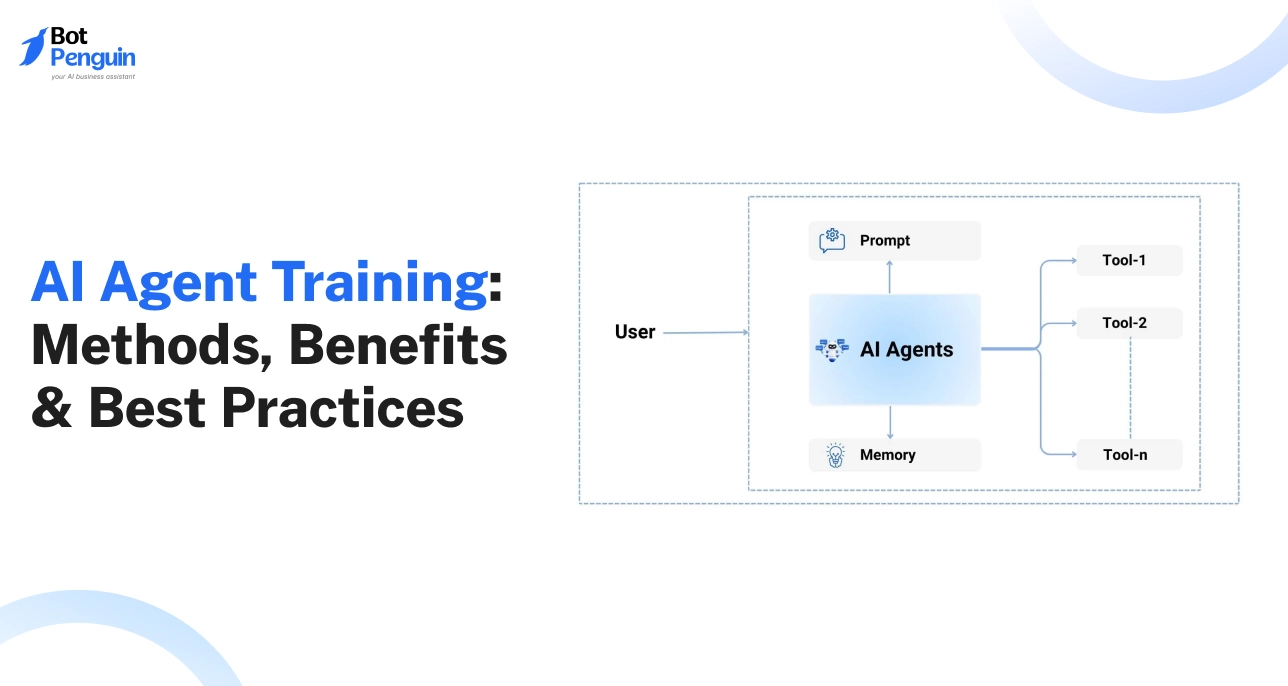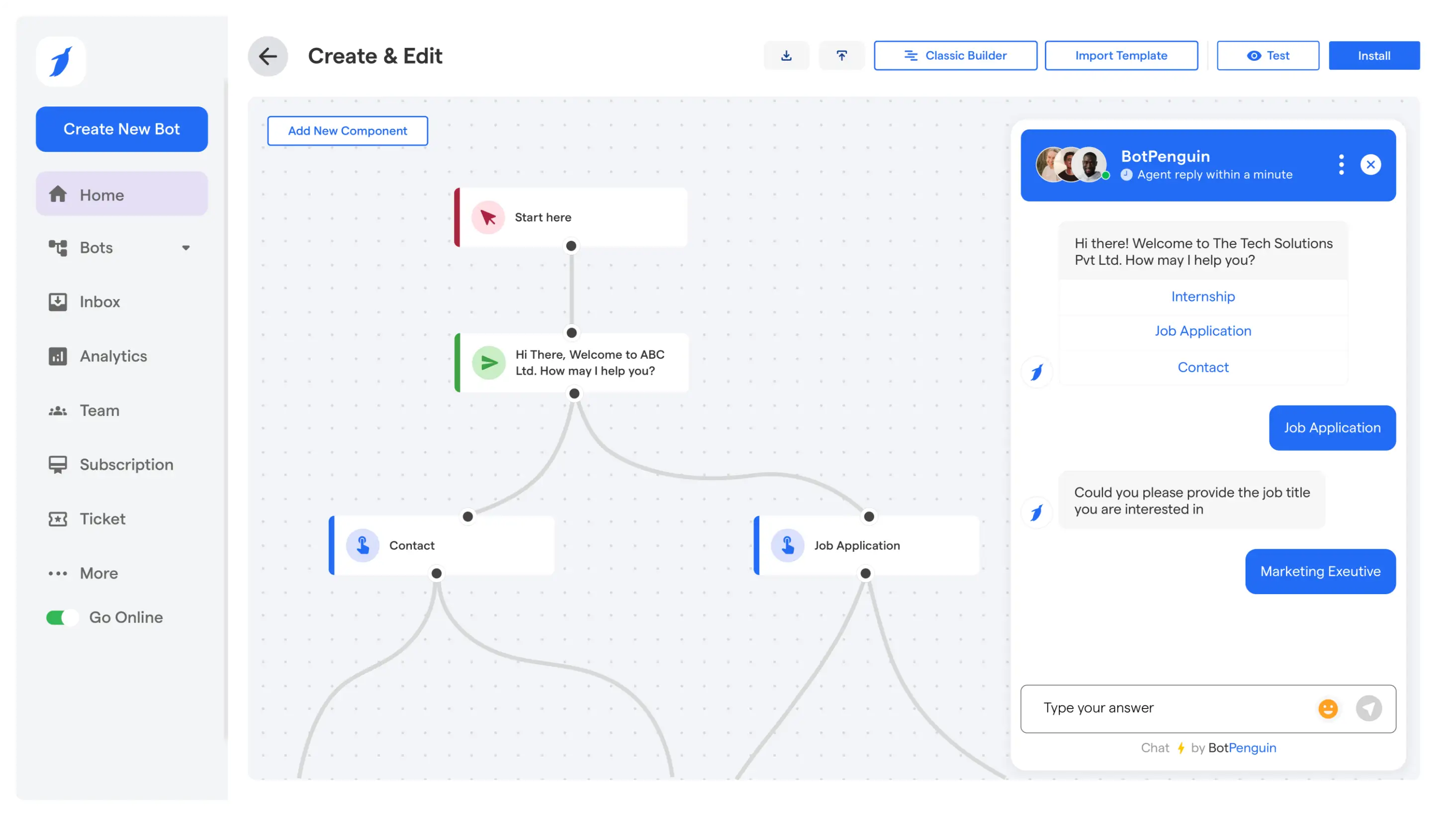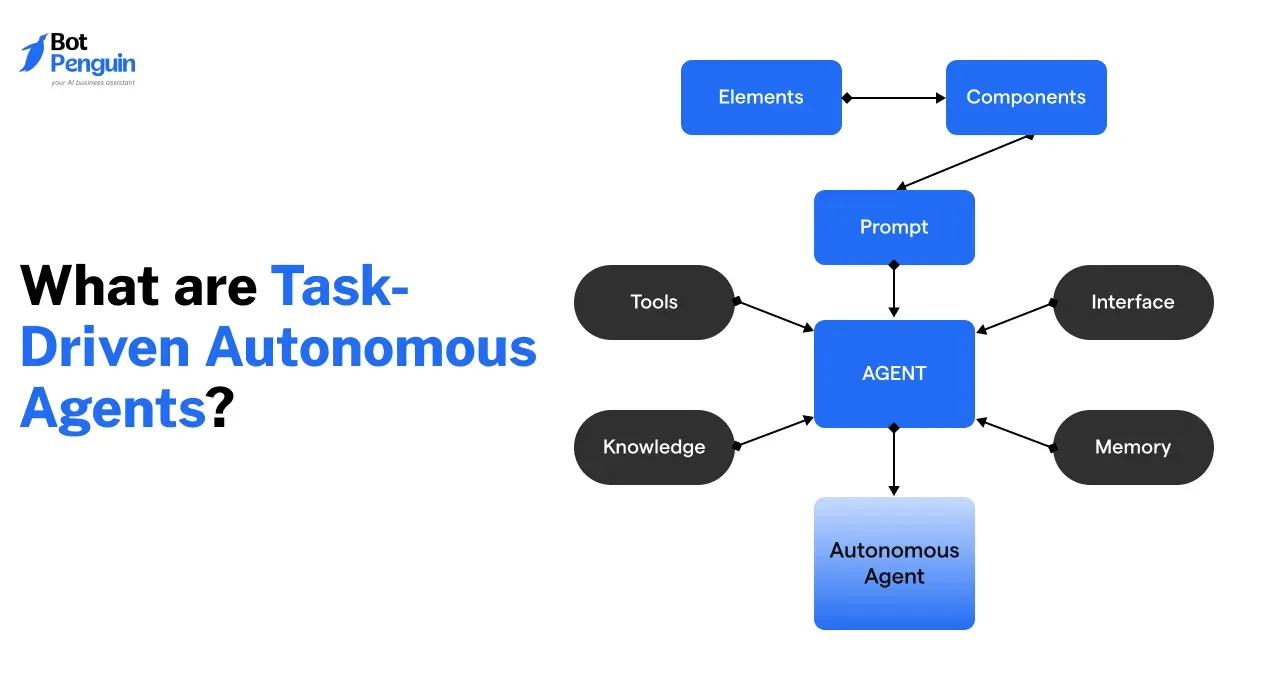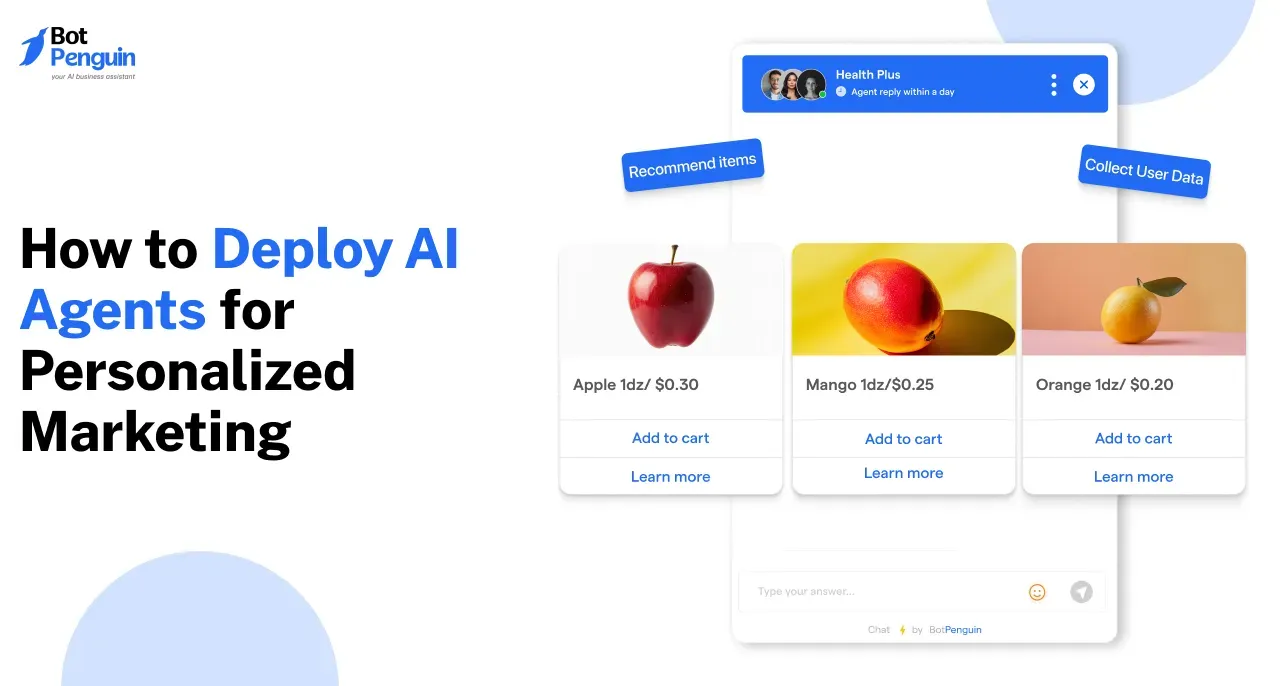Introduction
AI agents are no longer futuristic concepts; they are quietly running customer support desks, managing sales pipelines, and analyzing data faster than entire teams once could.
In 2025, businesses using AI agents report over a 40% increase in operational efficiency, proving that automation powered by intelligence is reshaping industries.
AI agent training is the process that makes this possible. It involves teaching an AI system to learn, adapt, and make decisions using real-world data, feedback, and iterative learning cycles.
Through proper training, these agents evolve from rule-based responders into autonomous problem solvers capable of handling dynamic business challenges.
The effectiveness of any AI agent depends on how well it is trained, not just on what model it uses. Quality training defines its accuracy, adaptability, and trustworthiness, turning it from a tool into a true digital teammate.
What is AI Agent Training?
AI agents training is the process of teaching an artificial system to understand data, interpret context, and take meaningful actions without constant human input.
It involves enabling the agent to recognize intent, learn from experience, and make independent decisions based on accumulated knowledge.
Unlike static automation, a trained AI agent refines its responses and strategies through continuous learning, ensuring better adaptability to complex business environments.
How AI Agents Learn
Training an AI agent requires feeding it diverse data sources such as customer interactions, emails, CRM records, or transaction logs. The agent uses this data to identify recurring patterns, link actions to results, and refine its responses.
Through feedback loops and reinforcement, it adjusts its behavior and becomes more accurate over time. This iterative process allows the agent to respond intelligently to changing contexts and user needs rather than relying on preprogrammed answers.
AI Agents vs Chatbots vs Machine Learning Models
To understand AI Agents better, let's understand the difference between AI Agents, chatbots, and other machine learning modelss
- Chatbots work on predefined rules or decision trees and provide static responses.
- Machine Learning Models focus on analyzing data and predicting outcomes but lack autonomous decision-making.
- AI Agents merge both intelligence and autonomy. They interpret context, understand user intent, and execute tasks like responding to customers, managing workflows, or triggering business actions across tools such as CRMs, ticketing systems, and marketing platforms.
Effective AI agents training builds systems that are not just reactive but capable of reasoning and improvement.
The next section covers how to train an AI agent using structured methods that ensure reliability, adaptability, and measurable performance gains.
How to Train an AI Agent?
Training an AI agent is a structured process aimed at building systems that can learn, adapt, and make decisions with precision.
It requires clear objectives, quality data, suitable tools, and continuous feedback. Both developers and non-technical professionals can follow this process to create AI agents that perform reliably and scale easily with business growth.
Define the Agent’s Objective
Purpose: The training journey starts by defining what you want the AI agent to accomplish. Clear objectives create focus and measurable outcomes.
Approach: Identify primary use cases such as customer query resolution, lead qualification, appointment scheduling, or campaign analytics.
Establish success metrics like accuracy, response time, or customer satisfaction.Example: A business can train your own AI agent to manage customer queries by recognizing FAQs and routing complex cases to live agents.
Within platforms like BotPenguin, this can be achieved easily through goal-based configuration, ensuring the AI aligns with real business tasks.Outcome: A defined purpose ensures each training step supports meaningful performance metrics and business impact.
Gather and Prepare Quality Data
Purpose: Accurate and well-structured data is essential for reliable AI performance.
Approach: Collect data from multiple sources such as CRM logs, chats, or support tickets. Clean, label, and balance it to reflect varied customer behavior.
BotPenguin simplifies this stage by allowing businesses to upload or sync data from their existing CRM or communication tools, creating a unified data pipeline for training.Example: For a retail business, including purchase records and customer inquiries helps the agent learn shopping preferences and product recommendations.
Outcome: High-quality, well-integrated data ensures training ai agents to recognize context accurately, adapt to different users, and reduce bias.
Choose the Right Model or Platform
Purpose: Choosing the right environment determines how effectively the agent learns and how quickly it can be deployed.
Approach: Technical users may opt for advanced models like GPT or Gemini, while teams seeking ease of use can utilize AI agent training platforms like BotPenguin, which offer prebuilt workflows, integrations, and customizable training parameters without coding.
Example: A service business can configure its AI agent on BotPenguin to integrate with its CRM, respond to leads instantly, and learn from every conversation.
Outcome: Selecting a scalable and no-code platform ensures faster setup, easier experimentation, and reduced dependence on engineering resources.
Implement Feedback Loops
Purpose: Feedback drives refinement. It helps the AI agent continuously learn from mistakes and adapt to evolving needs.
Approach: Monitor the agent’s conversations and collect user or operator feedback. On BotPenguin, responses can be corrected directly in the dashboard, automatically feeding improved examples into retraining cycles. This approach keeps the model updated with minimal manual intervention.
Example: If an AI support agent misclassifies a delivery issue, users can correct it through the BotPenguin interface, enhancing contextual understanding for future interactions.
Outcome: Regular feedback ensures better accuracy, responsiveness, and learning without restarting the training process.
Test and Iterate
Purpose: Testing validates how well the AI performs under different scenarios and ensures consistent accuracy.
Approach: Run tests using real interaction data and performance metrics such as response accuracy, context retention, and adaptability.
BotPenguin supports live testing environments, allowing teams to evaluate and retrain the agent directly within the platform.Example: A company can test its AI agent on new support tickets or campaign messages to ensure it adapts correctly to updates in tone or workflow.
Outcome: Continuous testing and retraining through a unified environment like BotPenguin improve long-term accuracy, reduce downtime, and maintain model relevance.
Methods of AI Agent Training
AI agents can be trained using several methodologies depending on the data available, learning objectives, and operational requirements.
From traditional supervised approaches to advanced large language model techniques, each method offers unique strengths in shaping how AI agents learn, respond, and evolve.
Understanding these methods helps businesses select the most effective training strategy for their goals.
Supervised Learning
Supervised learning ai agents are trained using labeled datasets where each input has a correct output. This approach relies on human guidance to ensure accuracy.
How it works: The system learns by comparing predictions against labeled answers and adjusting parameters to reduce errors. Over time, it identifies clear input-output patterns.
When to use it: Best suited for applications requiring defined outcomes such as intent recognition, sentiment analysis, or document classification.
Example: A customer service AI can be trained to categorize incoming messages as technical, billing, or feedback queries using thousands of pre-labeled conversations.
Unsupervised Learning
Unsupervised learning allows agents to analyze data without predefined labels, identifying hidden patterns and natural groupings.
How it works: The AI clusters or organizes data based on shared characteristics and relationships, uncovering insights without human labeling.
When to use it: Ideal for market segmentation, behavioral analytics, and recommendation systems.
Example: Training ai agents using unsupervised methods enables automatic grouping of customers based on purchase frequency and communication tone to improve targeting strategies.
Reinforcement Learning
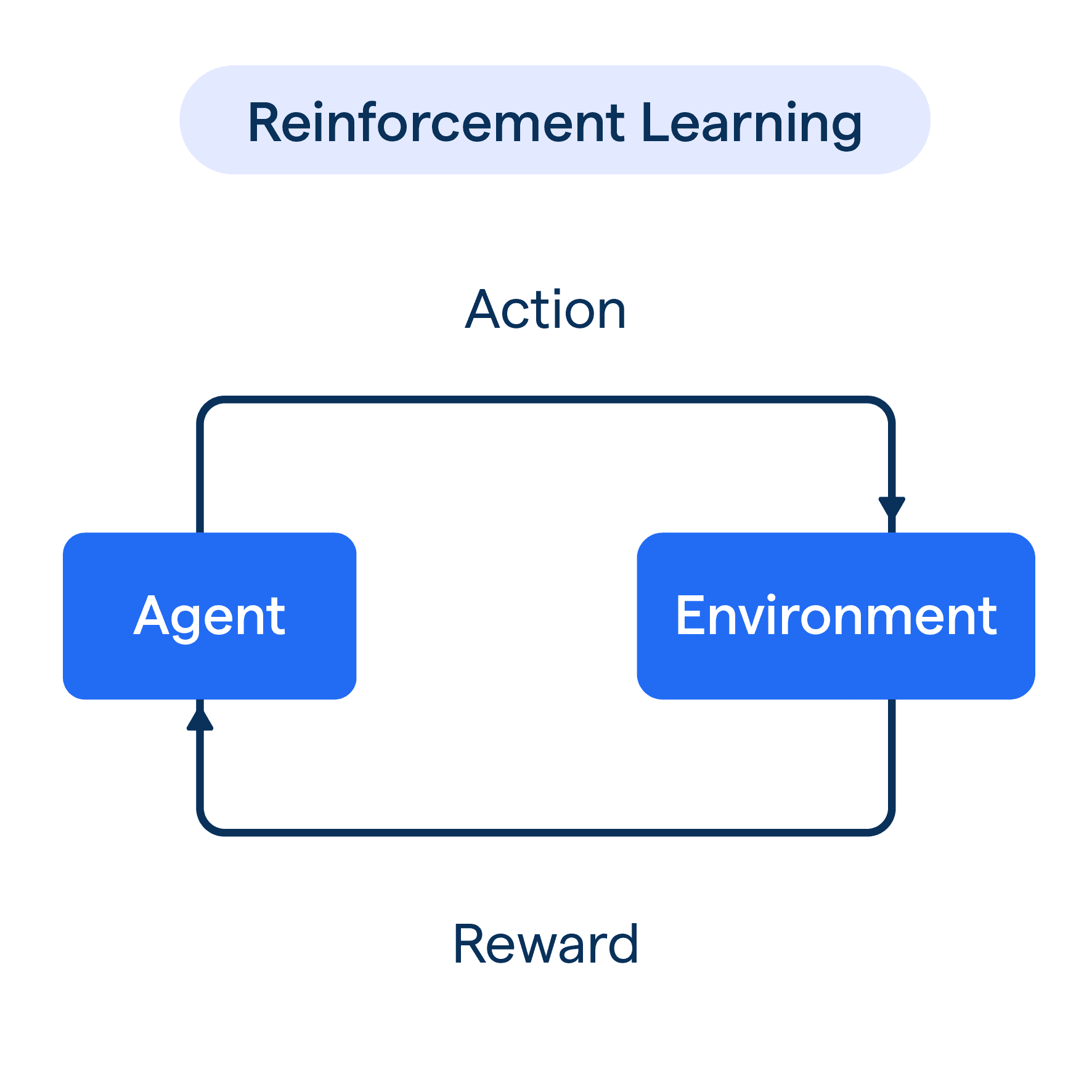
Reinforcement learning ai agent models learn through trial, feedback, and reward-based adjustments to improve performance.
How it works: The agent performs actions, evaluates results, and modifies its strategy to maximize positive outcomes over time.
When to use it: Useful for dynamic, goal-oriented tasks such as decision-making, process automation, or robotic control.
Example: An AI logistics planner learns to optimize delivery routes by earning rewards for shorter travel times and penalties for delays.
Few-Shot and Zero-Shot Learning
These modern learning approaches enable AI agents to perform new tasks using minimal or no labeled examples.
How it works: Few-shot learning relies on limited examples for training, while zero-shot learning generalizes knowledge from prior tasks to new ones.
When to use it: Best suited for rapid deployment environments where extensive data collection is impractical.
Example: A company can train your own AI agent to answer new types of customer questions using only a small set of prior interactions.
Scenario-Based or Simulation Training
Scenario-based AI training exposes agents to realistic simulations that mirror real-world environments.
How it works: The agent practices responding to virtual situations, refining its performance before interacting with actual users.
When to use it: Effective for high-risk or interactive roles like customer support, troubleshooting, and risk management.
Example: A support AI trained through chat simulations learns to handle refund requests or complaint escalations accurately before going live.
Each training method contributes to how effectively AI agents learn and adapt. Supervised learning ensures precision, unsupervised learning uncovers insights, and reinforcement learning builds decision-making ability.
Few-shot and simulation-based training accelerate learning with minimal data. Combining these methods enables the creation of intelligent, context-aware agents ready for real-world performance.
The next section explores the benefits of AI agent training and how it enhances efficiency, accuracy, and business scalability.
Benefits of AI Agent Training
Effective AI agents training directly influences how accurately and intelligently an agent performs in real-world situations.
Well-trained agents can adapt to different user needs, handle complex scenarios, and scale effortlessly as data grows.
For both technical teams and business professionals, the outcomes of quality training extend beyond operational efficiency—they enhance decision-making, personalization, and long-term reliability.
When AI agents are trained with the right methods and feedback mechanisms, they evolve from simple automated responders into adaptive systems that continuously learn and improve.
The following are key benefits of AI agent training that define its importance across industries.
Improved Accuracy and Adaptability
Trained AI agents interpret data contextually, resulting in more accurate and relevant responses. By learning from varied datasets and feedback cycles, they adapt to different communication styles and complex queries.
For example, in a customer service setup, a well-trained agent can identify tone, urgency, and intent to provide precise answers or escalate issues appropriately. Continuous exposure to new data keeps accuracy and contextual understanding high.
Increased Efficiency and Scalability
Automation powered by trained agents reduces manual workload and enables businesses to scale without expanding resources.
Agents can handle multiple customer interactions simultaneously, manage repetitive queries, and process data faster than manual systems.
As a result, businesses achieve higher productivity while maintaining service quality. A single trained model can also be replicated across departments, ensuring consistent performance at scale.
Enhanced Personalization and Engagement
Through AI agents training, systems learn individual user preferences, behaviors, and patterns. This understanding enables personalized communication and recommendations.
In retail or eCommerce, for example, trained AI agents can tailor product suggestions or offers based on previous interactions, increasing engagement and conversion rates.
The personalization extends to tone and timing, improving the overall customer experience.
Continuous Improvement Over Time
AI agents do not remain static after deployment. With structured feedback and retraining, they continue to evolve, refining their responses and decision-making accuracy.
This ensures they stay aligned with new data, user behavior, and market trends. Over time, trained AI agents become more reliable, consistent, and valuable as data and business complexity grow.
The benefits of AI agent training extend from accuracy and efficiency to adaptability and long-term learning. For organizations, it means smarter automation and improved performance across functions.
The next section explores the best practices for training AI agents, detailing how structured methods can maintain accuracy and ethical standards throughout the training process.
Best Practices for AI Agent Training
Building high-performing and trustworthy AI agents requires following structured, ethical, and data-driven practices.
Beyond model selection and algorithms, the effectiveness of AI agent training depends on how goals are defined, data is managed, and feedback is applied. Following proven standards ensures that agents remain accurate, compliant, and adaptable as they evolve.
Below are key best practices for AI training that help maintain transparency, quality, and performance throughout every stage of development.
1. Start with Clear Goals and KPIs
Training begins with defining measurable goals. Each phase of training ai agents should have specific objectives that align with business outcomes.
Examples include improving response accuracy, reducing ticket resolution time, or increasing lead qualification efficiency. Setting Key Performance Indicators (KPIs) helps measure progress and identify areas for improvement.
Scenario: A customer support team can define KPIs like average handling time or first-response accuracy to track how well the trained agent performs compared to human benchmarks.
Key takeaway: Clear goals provide a foundation for targeted learning and make results quantifiable.
2. Maintain Data Quality and Diversity
The quality of data directly impacts the performance of any AI system. Ensure training datasets are accurate, up-to-date, and representative of real-world variations.
Include diverse data sources to avoid reinforcing bias.
Scenario: For an AI agent handling customer feedback, using data from multiple languages, regions, and demographics helps it respond inclusively and appropriately.
Key takeaway: Balanced, diverse datasets ensure fairness and improve generalization in ai agent training.
3. Keep Human-in-the-Loop Validation
Human expertise remains essential for refining model accuracy and contextual understanding.
Continuous validation by domain experts ensures that the agent’s responses align with real-world expectations.
Scenario: When an AI sales assistant misclassifies a lead, human review and correction improve accuracy for future predictions.
Key takeaway: Expert oversight maintains consistency, reduces bias, and strengthens trust in AI-driven outcomes.
4. Prioritize Ethical and Privacy Compliance
Ethical and regulatory compliance must be integrated into every training phase.
Follow recognized frameworks such as GDPR, ISO 27001, or local data governance rules to protect user privacy and maintain accountability.
Scenario: Before deploying a chatbot, anonymizing personal data and applying access controls ensures compliance and user trust.
Key takeaway: Responsible data handling builds transparency and long-term reliability in training ai agents.
5. Document and Retrain Regularly
AI agents evolve with time and data. Regular documentation of changes, data versions, and training results ensures traceability and accountability.
Retraining at scheduled intervals keeps the system aligned with new business needs and user patterns.
Scenario: A financial advisory agent retrained quarterly with updated market data provides more accurate recommendations.
Key takeaway: Consistent retraining sustains performance and adaptability while reducing outdated or biased responses..
Common Challenges in AI Agent Training
Even with well-planned strategies, AI agents training often encounters practical challenges that affect accuracy, consistency, and scalability.
These issues arise from the nature of data, the complexity of learning models, and the infrastructure used.
Identifying these challenges early allows teams to apply corrective measures and maintain model reliability. The following are key challenges in AI training and their practical solutions.
Data Inconsistency and Bias
Inconsistent or biased datasets lead to inaccurate predictions and unfair outcomes. Data collected from limited sources or user groups can distort model understanding.
Solution: Use diverse, high-quality data and conduct regular audits to detect and correct bias. Ensure training datasets represent varied demographics, languages, and user behaviors.
Overfitting and Hallucinations
Overfitting occurs when a model performs well on training data but poorly on new inputs. Hallucinations happen when agents generate irrelevant or incorrect information.
Solution: Implement validation datasets and regular testing. Limit model complexity and use fine-tuning with human review to prevent overconfidence in wrong predictions.
Integration Issues with Legacy Systems
Older business systems may not support AI integration, causing deployment delays and workflow disruption.
Solution: Use APIs and middleware to connect legacy infrastructure with AI platforms. Gradual integration ensures minimal operational risk and faster adoption.
Computational Cost and Scaling
Training large AI models demands high computing power and storage, often increasing costs.
Solution: Optimize model size, leverage cloud computing resources, and schedule retraining cycles strategically to reduce unnecessary load.
Lack of Interpretability
Many AI models function as black boxes, making it hard to explain their decisions to stakeholders.
Solution: Use explainable AI frameworks and visualization tools that help track how decisions are made. Maintain transparency through documentation and human oversight.
Understanding these challenges in AI training helps organizations design better, more reliable systems. By addressing data quality, scalability, and transparency, businesses can create AI agents that perform consistently and integrate smoothly.
The next section explores the future of AI agent training and emerging trends shaping intelligent automation.
Why Businesses Choose BotPenguin for AI Agent
As businesses continue to adopt AI-driven solutions, choosing the right AI agent platform becomes a defining factor for scalability and efficiency.
BotPenguin stands out as a practical, accessible, and future-ready solution for organizations seeking to automate without technical limitations.
It simplifies how teams train, deploy, and manage AI agents through a combination of no-code tools, integrated systems, and advanced AI models.
Simplified Training Environment
BotPenguin provides an intuitive no-code environment where users can configure AI behaviors, define workflows, and manage feedback without programming knowledge.
This enables both technical and non-technical teams to design and refine intelligent agents tailored to their goals. Continuous feedback integration ensures every trained agent evolves with real-world interactions.
80+ Integrations for Business Use
The platform connects with over 80+ business tools, including CRMs, marketing platforms, and ticketing systems.
These integrations help teams synchronize customer data, automate repetitive processes, and maintain unified communication across platforms. Businesses can train and deploy agents that operate directly within their existing workflows.
Advanced Learning Models
BotPenguin supports industry-leading AI models such as GPT, Claude, and Gemini. This allows users to train agents with deep contextual understanding and high adaptability across industries.
The models handle complex reasoning, multi-step decision-making, and personalized interactions with precision.
Scalable, Compliant, and Customizable
Enterprises benefit from BotPenguin’s scalability, compliance readiness, and flexibility.
The platform is GDPR-compliant, SOC 2-aligned, and supports white-label configurations for agencies managing multiple clients. It ensures secure data handling and customizable branding options for partners and resellers.
With BotPenguin AI agent, organizations gain the infrastructure to build adaptive and intelligent systems that scale effortlessly.
Conclusion
Effective AI agent training is the foundation of intelligent, reliable, and adaptive systems. It determines how accurately an agent understands context, learns from interactions, and performs across complex environments.
Organizations investing in structured training processes gain measurable improvements in accuracy, efficiency, and user engagement.
Modern businesses are moving toward platforms that simplify training and ensure compliance without heavy technical dependency.
Tools like BotPenguin AI agents make it possible to train, deploy, and scale intelligent agents with transparency and control. These platforms integrate data management, real-time feedback, and advanced models to help teams build smarter systems faster.
Experimenting with such solutions enables organizations to automate responsibly while maintaining quality and adaptability. AI agent training done right transforms technology into a strategic asset that continuously learns and contributes to sustainable business growth.
Frequently Asked Questions (FAQs)
What are the key components involved in effective AI agent training?
Effective AI agent training requires a combination of clear objectives, quality datasets, model selection, and feedback mechanisms.
These elements ensure that agents learn efficiently, handle real-world variations, and improve accuracy over time.
How can businesses use AI agents training to enhance customer experience?
Through AI agents training, businesses can develop systems that understand user intent, personalize interactions, and resolve issues faster.
Well-trained agents can identify customer needs and deliver relevant responses, improving satisfaction and retention.
What factors should be considered when selecting an AI agent training platform?
When choosing an AI agent training platform, organizations should assess integration capabilities, data security, compliance standards, and support for advanced learning models.
The platform should also allow customization and scalability to match business growth.
How often should companies retrain their AI agents for consistent performance?
To maintain reliability, companies should retrain their AI agents regularly as data, customer behavior, and workflows evolve.
Consistent training ai agents helps them stay updated and prevents outdated or inaccurate responses.
What are the emerging trends shaping the future of AI agent training?
The future of AI agent training includes autonomous self-learning systems, low-code environments, and adaptive models capable of real-time context learning.
These advancements are making AI implementation faster, more accessible, and more efficient for all industries.
